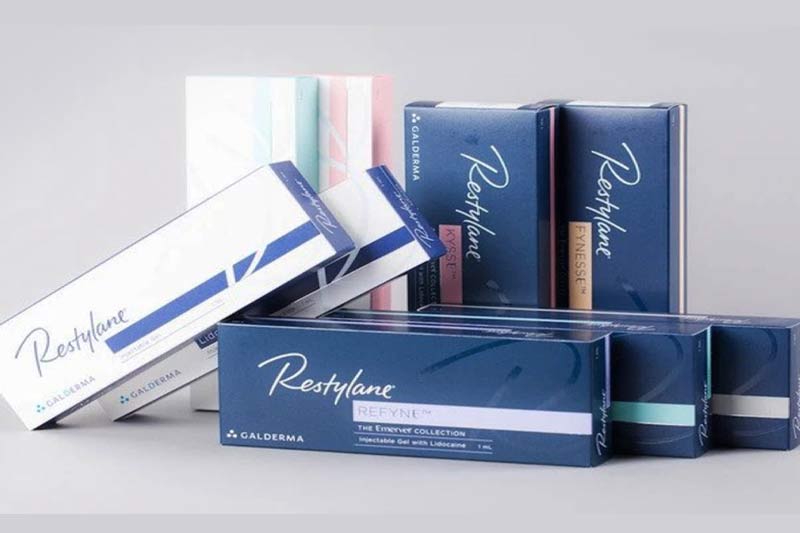The saying “Beauty comes from within” holds true but no matter how devoted we are to mindful living, environmental factors and aging end up leaving a mark on our skin.
That’s why we need assistance from the outside. Innovative cosmetic treatments provide that help quickly and effectively.
Today’s most popular beautifying procedures are injectable treatments that correct wrinkles and plump up the skin. The most popular brands are Botox and Restylane.
Let’s see how Botox and Restylane work, how they differ, and which treatment to choose.

Restylane Overview
Restylane is a brand of dermal filler injectables. Designed and FDA-approved to plump up the mid-face area, Restylane reduces wrinkles and folds that form due to aging-related loss of volume and elasticity. It is also approved to smooth the back of the hands.
The main ingredient in Restylane products is hyaluronic acid, a sugar compound that occurs naturally in our bodies. Its concentrations decrease over time, so synthetically derived HA in Restylane works to replace depleted HA, increasing the skin’s moisture levels and plumping up the skin.
Botox Overview
Botox is a brand of neurotoxin injectables designed and FDA-approved to reduce the appearance of lines and wrinkles in the upper section of the face.
The main ingredient in Botox injectables is botulinum toxin A, a protein derived from the bacteria Clostridium botulinum. Its function is to block nerve signals from the brain that cause our muscles to move. By relaxing facial muscle movement, the skin above the muscle becomes tighter and smoother.
Restylane Vs. Botox
Restylane and Botox are among the most popular anti-aging treatments. The procedures are similar, and they provide similar results, but they are designed to treat different facial areas and their results differ in duration.
The following table sums up Restylane and Botox similarities and differences.
| Restylane | Botox | |
|---|---|---|
| Main ingredient | Hyaluronic acid | Botulinum toxin type A |
| Treatment areas | Cheeks Chin Nasolabial folds Perioral lines Lips Hands | Glabellar lines (frown lines) Forehead lines Crow’s feet lines |
| Onset of results | Immediate | Within three days |
| Results duration | Six to 18 months | Up to six months |
| Cost | $625 - $794 per syringe | $12.50 per unit |
What Areas Can Be Treated?
Restylane products are FDA-approved for the following areas:
- Cheeks
- Chin
- Nasolabial folds
- Lips
- Perioral wrinkles
- Midface contours
- Hands
Restylane is commonly used off-label to treat the tear-trough (under-eye) area.
The FDA approved Botox for these areas:
- Glabellar lines (frown lines)
- Forehead wrinkles
- Crow’s feet
Botox is used off-label to reduce wrinkles on the nose (bunny lines), chin, neck, eyebrows, and around the mouth.
Botox Vs. Restylane Results
Depending on the treatment area, Restylane patients enjoy fuller lips, corrected lip asymmetries, plumper cheeks, less visible nasolabial folds, reduced lines around the mouth, and smoother, rejuvenated skin. The results last up to 18 months, depending on the type of Restylane product, the patient’s metabolism, lifestyle habits, etc.
Botox reduces the appearance of moderate to severe lines and wrinkles in the upper facial area. Patients have smoother skin and a limited ability to move the muscles in the treatment area. This prevents overly expressive facial movements, which form wrinkles. Botox results last up to six months.
Common Side Effects
Botox and Restylane patients usually experience mild or no side effects.
This table breaks down the side effects of both treatments.
| Restylane | Botox | |
|---|---|---|
| Common side effects | Swelling Redness Pain Bruising Headache Tenderness Lump formation Itching | Bruising Swelling Redness Pain Headache |
| Rare side effects | Allergic reaction Scabs or scars Infection Impaired vision Impaired hand function Stroke | Droopy eyelid Muscle weakness Trouble breathing Trouble speaking Trouble swallowing Impaired vision Loss of bladder control |
If you experience severe symptoms after the treatment, contact your medical provider right away.
Who Should Avoid the Treatment?
Restylane and Botox are safe for most healthy adults over 21. Patients with certain diseases or conditions should avoid the treatment.
The following conditions may prevent you from having a Restylane treatment:
- Pregnancy
- Breastfeeding
- Previous allergies
- Bleeding disorders
These conditions may pose a safety risk for potential Botox patients:
- Pregnancy
- Breastfeeding
- Previous allergies
- Skin infection at the treatment area
- Muscle or nerve conditions
- Bleeding disorders
Note: Are you still in doubt whether Botox is for you? Read botox pros and cons, where we break down what you need to consider before getting Botox, or simply look up botox alternatives for removing wrikles.
Consult your chosen medical provider about any health issues and the potential risk of undergoing a Botox or Restylane procedure. Disclose information about the medication you are taking because some drugs may increase the chance of side effects.
Cost
The cost of Restylane and Botox treatments depends on your chosen medical provider’s location, expertise and your skin goals.
At Vibrant Skin Bar, one unit of Botox costs $13.50. The total cost of the treatment typically ranges between $250 and $750.
Restylane products cost between $749 (Restylane Silk) and $749 (Restylane Lyft) per syringe.
Conclusion
Innovative cosmetic injectable treatments like Restylane and Botox help men and women maintain a youthful appearance and glow. Both treatments are FDA-approved, quick, and provide amazing results, justifying their popularity.
If you are ready to try Restylane or Botox, make sure you go to a reputable medical provider with years of experience helping patients fight aging signs and improve their complexion.


